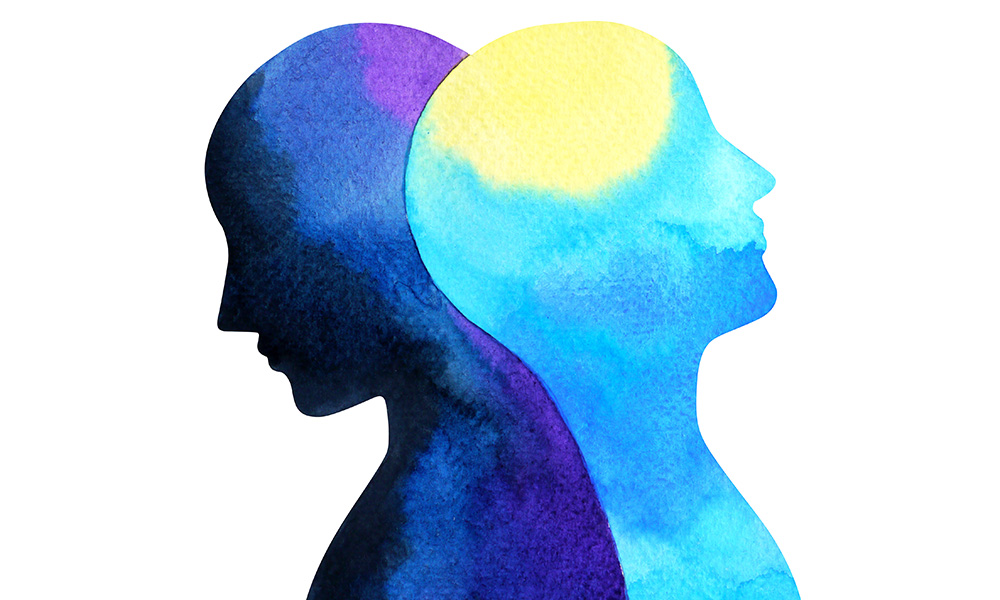Primary care providers are often the first to encounter bipolar symptoms in patients. Here’s what you should know.

Bipolar disorder commonly is seen first in primary care settings, although it is a relatively rare condition — only about 1% of people will struggle with it in their lifetime. The treatment of bipolar disorder often is supervised by patients’ primary care physicians and not a psychiatric specialist.
“Bipolar disorder is a severe but manageable form of a mood disorder,” said John J. Wernert III, M.D., psychiatrist and executive medical director of Norton Behavioral Medicine. “One of the biggest challenges you’ll face in primary care is recognizing the complexity, level of stress and history of trauma of patients that you’re seeing,” Dr. Wernert said. “The correct diagnosis of bipolar is really important, because this condition is often misdiagnosed. Patients who describe unstable mood or irritability are not necessarily bipolar.
“Onset is commonly a depressive episode that occurs in adolescence or early adulthood. Patients who tell you they are bipolar before a correct diagnosis are almost always incorrect. True bipolar patients rarely offer details except that they’re not feeling well. We typically get a diagnosis from speaking with family members or from a thorough health history.”
Bipolar disorder symptoms
The hallmark of bipolar disorder is extreme mood swings. Patients move between emotional highs (manic episodes, mania or hypomania) and lows (depression or depressive episodes). Typical onset for bipolar disorder is the teenage years or in the early 20s.
Mania or manic symptoms tend to last one, sometimes two weeks. Left untreated, mania can linger for three to six months.
“During true manic episodes, patients can become psychotic about 30% of the time,” Dr. Wernert said. “It’s important for primary care physicians to remember that when patients experience these episodes, they have very little insight into what’s happening with them. Typically they will either get admitted to the hospital, be seen in the emergency room or unfortunately be arrested by law enforcement because of their behavior.”
Bipolar manic episode symptoms include:
- Periods that range from euphoria to almost delirium
- Feelings of increased self-esteem, increased energy and psychomotor agitation
- Racing thoughts
- Pressured speech
- Poor sleep
- Hypersexuality
- Impulsivity
- Disinhibited social behavior
- Impaired judgement
Depressive episodes and symptoms of bipolar depression can last between six and 12 months without treatment. Treatment can reduce that time to three or four months. It is important to know if the patient has unipolar depression or if they are in the depressive phase of a bipolar cycle.
Bipolar depressive episode symptoms include:
- Feeling slow or tired
- Trouble with concentration and decision-making
- Difficulty falling asleep or staying asleep; waking too early or sleeping too much
- Lack of interest in almost all activities, including favorite hobbies, etc.
- Difficulty performing simple daily tasks
- Feelings of hopelessness, worthlessness and suicidal ideation
Refer a patient
To refer a patient to Norton Behavioral Health visit Norton EpicLink and open an order for behavioral health.
Bipolar I vs. bipolar II
Bipolar II disorder is a variation of bipolar I. Instead of full-blown manic episodes, patients become hypomanic, which is a less dramatic swing into mania. These episodes typically last for about four days and are often brought on by stress.
“Patients will deny they have problems, but typically the family sees it, so a spouse or a family member can report on the patient’s behavior,” Dr. Wernert said. “There is also no decreased functioning, psychosis or hallucinations, and hypomanic episodes rarely progress to the full mania.”
Bipolar I also can include rapid cycling, which is four or more episodes of mania or depression within one year.
Comorbidities of bipolar disorder
Many patients with bipolar disorder also have other mental illness, mood disorders or conditions such as:
- Anxiety disorders
- Attention-deficit/hyperactivity disorder, known as ADHD
- Substance abuse disorder
- Eating disorders
- Personality disorder
Often, in primary care, patients present with mood issues and accompanying somatic symptoms. According to Dr. Wernert, 71% of bipolar patients also will have some type of diagnosable anxiety disorder, about 56% will have a substance use disorder, and about 36% a personality disorder.
“Personality disorder is less frequently diagnosed, mainly because of changes in the diagnostic manual,” Dr. Wernert said. “A personality disorder is not a diagnosis about or commenting on someone’s character or innate personality. It deals with the disruptive nature of these conditions.”
Attention-deficit disorder is frequently diagnosed consecutively with bipolar disorder.
“Most commonly in primary care, the presence of masked post-trauma syndromes causes people feel like they might be bipolar,” Dr. Wernert said. “We have to check for trauma and excessive anxiety and irritability in those cases.”
“Sometimes, patients have thought disorders like schizophrenia or schizoaffective disorder. In those conditions, hallucinations, paranoia and delusions will persist even with treatment. In bipolar patients, psychotic symptoms usually resolve after their mood stabilizes. Hallucinations persist if the patient has schizophrenia or schizoaffective disorder.
“If the patient has not had an initial manic episode, and has no history of manic symptoms, we can consider a diagnosis of unipolar depression. About 1% of patients are truly bipolar, and about 25% have unipolar depression.”
Management strategies for patients diagnosed with bipolar disorder
Bipolar disorder is a manageable illness if the patient remains compliant with treatment. Treatment of bipolar disorder should include medication and supportive psychotherapy. Yearly checkups after initial diagnosis of bipolar disorder and subsequent stabilization are also recommended.
“Bipolar disorder patients are at high risk of polypharmacy, as they typically take multiple medications to treat symptoms rather than the condition,” Dr. Wernert said. “But bipolar prognosis is very good. Prescriptions and psychotherapies work well, and patients respond best to these, particularly mood stabilizers, but not necessarily antidepressants.
“Over 200 studies have been done in the last 15 years about the best bipolar disorder medication, and of interest is the fact that lithium comes out No. 1 in every single study. Other medications can be added as mood stabilizers, but lithium is clearly the most effective, even in small doses.”
According to Dr. Wernert, many primary care providers may be hesitant to prescribe lithium, as it is an older drug and has been prescribed for mania since the late 1940s.
“You can use small doses of lithium, because a low dose is better than nothing,” he said. “Lithium can be safely prescribed to patients after a clear basic metabolic profile and thyroid panel, and they should have had an EKG [electrocardiogram] within the last year.”
Dr. Wernert offers a warning, however: “If you’re going to use antidepressants, make sure that you realize it’s controversial, and use them cautiously. Antipsychotics should be used during the manic episode and discontinued in three to four months.”
For poorly compliant patients, long-acting injectable medications can be used for six to nine months. These can help stabilize the patient until they can wean off those medications.
It is important to closely monitor a patient who presents with depression.
“If you prescribe an SSRI [selective serotonin reuptake inhibitor] or tricyclic medication, [the patient will] feel better within three to four weeks. At about six weeks, they will start feeling elated. By eight weeks, they’re full-blown manic,” Dr. Wernert said. “Unfortunately, once that happens, there may be potential hospitalization or the need for more aggressive treatment.”
Those treatments may include electroconvulsive therapy.
Over their lifetime, bipolar patients have about a 6% suicide rate, and about 30% to 40% develop symptoms of self-harm or self-mutilation.
“It’s important to be on top of a bipolar disorder diagnosis and make sure that patients have adequate support and backup to make sure that they don’t lapse into manic episodes or depressive episodes,” Dr. Wernert said.
Bipolar disorder can be a challenging mental illness to diagnose for primary care physicians, and it’s important to consider the patient’s age, trauma history and other factors while deciding on a course of treatment.

